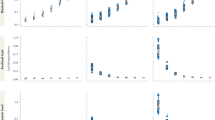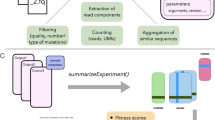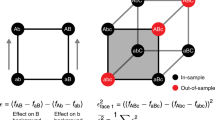Abstract
Pooled sequencing-based fitness assays are a powerful and widely used approach to quantifying fitness of thousands of genetic variants in parallel. Despite the throughput of such assays, they are prone to biases in fitness estimates, and errors in measurements are typically larger for deleterious fitness effects, relative to neutral effects. In practice, designing pooled fitness assays involves tradeoffs between the number of timepoints, the sequencing depth, and other parameters to gain as much information as possible within a feasible experiment. Here, we combined simulations and reanalysis of an existing experimental dataset to explore how assay parameters impact measurements of near-neutral and deleterious fitness effects using a standard fitness estimator. We found that sequencing multiple timepoints at relatively modest depth improved estimates of near-neutral fitness effects, but systematically biased measurements of deleterious effects. We showed that a fixed total number of reads, deeper sequencing at fewer timepoints improved resolution of deleterious fitness effects. Our results highlight a tradeoff between measurement of deleterious and near-neutral effect sizes for a fixed amount of data and suggest that fitness assay design should be tuned for fitness effects that are relevant to the specific biological question.






Similar content being viewed by others
Data availability
Raw sequencing reads have been deposited in the NCBI BioProject database under accession number PRJNA814281. Processed data are deposited on Zenodo (https://doi.org/10.5281/zenodo.6547536), and source code for sequencing pipeline, downstream analyses, and figure generation are available at GitHub (https://github.com/baymlab/2022_Limdi_limits-pooled-fitness-assays).
References
Ascensao JA, Wetmore KM, Good BH, Arkin AP, Hallatschek O (2023) Quantifying the local adaptive landscape of a nascent bacterial community. Nat Commun 14:248
Baryshnikova A, Costanzo M, Kim Y, Ding H, Koh J, Toufighi K, Youn J-Y, Ou J, San Luis B-J, Bandyopadhyay S et al (2010) Quantitative analysis of fitness and genetic interactions in yeast on a genome scale. Nat Methods 7:1017–1024
Breslow DK, Cameron DM, Collins SR, Schuldiner M, Stewart-Ornstein J, Newman HW, Braun S, Madhani HD, Krogan NJ, Weissman JS (2008) A comprehensive strategy enabling high-resolution functional analysis of the yeast genome. Nat Methods 5:711–718
Carrasquilla, M., Drammeh, N.F., Rawat, M., Sanderson, T., Zenonos, Z., Rayner, J.C., and Lee, M.C.S. (2022). Barcoding genetically distinct Plasmodium falciparum strains for comparative assessment of fitness and antimalarial drug resistance. https://doi.org/10.1101/2022.04.05.487250
Chevin L-M (2011) On measuring selection in experimental evolution. Biol Lett 7:210–213
Du D, Roguev A, Gordon DE, Chen M, Chen S-H, Shales M, Shen JP, Ideker T, Mali P, Qi LS et al (2017) Genetic interaction mapping in mammalian cells using CRISPR interference. Nat Methods 14:577–580
Fowler DM, Fields S (2014) Deep mutational scanning: a new style of protein science. Nat Methods 11:801–807
Fowler DM, Araya CL, Fleishman SJ, Kellogg EH, Stephany JJ, Baker D, Fields S (2010) High-resolution mapping of protein sequence-function relationships. Nat Methods 7:741–746
Hall BG, Acar H, Nandipati A, Barlow M (2014) Growth rates made easy. Mol Biol Evol 31:232–238
Jaffe M, Sherlock G, Levy SF (2017) iSeq: a new double-barcode method for detecting dynamic genetic interactions in yeast. G3 7:143–153
Kelsic ED, Chung H, Cohen N, Park J, Wang HH, Kishony R (2016) RNA structural determinants of optimal codons revealed by MAGE-Seq. Cell Syst 3:563-571.e6
Lenski RE, Rose MR, Simpson SC, Tadler SC (1991) Long-term experimental evolution in Escherichia coli. I. adaptation and divergence during 2,000 generations. Am Nat 138:1315–1341
Li F, Salit ML, Levy SF (2018) Unbiased fitness estimation of pooled barcode or amplicon sequencing studies. Cell Syst 7:521-525.e4
Li F, Tarkington J, Sherlock G (2023) Fit-Seq2.0: an improved software for high-throughput fitness measurements using pooled competition assays. J Mol Evol. https://doi.org/10.1007/s00239-023-10098-0
Limdi A, Owen SV, Herren C, Lenski RE, Baym M (2022) Parallel changes in gene essentiality over 50,000 generations of evolution. bioRxiv. https://doi.org/10.1101/2022.05.17.492023
Nguyen Ba AN, Lawrence KR, Rego-Costa A, Gopalakrishnan S, Temko D, Michor F, Desai MM (2022) Barcoded bulk QTL mapping reveals highly polygenic and epistatic architecture of complex traits in yeast. Elife. https://doi.org/10.7554/eLife.73983
Robinson DG, Chen W, Storey JD, Gresham D (2014) Design and analysis of bar-seq experiments. G3 4:11–18
Shalem O, Sanjana NE, Hartenian E, Shi X, Scott DA, Mikkelson T, Heckl D, Ebert BL, Root DE, Doench JG et al (2014) Genome-scale CRISPR-Cas9 knockout screening in human cells. Science 343:84–87
Smith AM, Heisler LE, Mellor J, Kaper F, Thompson MJ, Chee M, Roth FP, Giaever G, Nislow C (2009) Quantitative phenotyping via deep barcode sequencing. Genome Res 19:1836–1842
Smith AM, Heisler LE, St Onge RP, Farias-Hesson E, Wallace IM, Bodeau J, Harris AN, Perry KM, Giaever G, Pourmand N et al (2010) Highly-multiplexed barcode sequencing: an efficient method for parallel analysis of pooled samples. Nucleic Acids Res 38:e142
Stiffler MA, Hekstra DR, Ranganathan R (2015) Evolvability as a function of purifying selection in TEM-1 β-lactamase. Cell 160:882–892
Thompson DA, Desai MM, Murray AW (2006) Ploidy controls the success of mutators and nature of mutations during budding yeast evolution. Curr Biol 16:1581–1590
van Opijnen T, Camilli A (2013) Transposon insertion sequencing: a new tool for systems-level analysis of microorganisms. Nat Rev Microbiol 11:435–442
Venkataram S, Dunn B, Li Y, Agarwala A, Chang J, Ebel ER, Geiler-Samerotte K, Hérissant L, Blundell JR, Levy SF et al (2016) Development of a comprehensive genotype-to-fitness map of adaptation-driving mutations in yeast. Cell 166:1585-1596.e22
Wang T, Wei JJ, Sabatini DM, Lander ES (2014) Genetic screens in human cells using the CRISPR-Cas9 system. Science 343:80–84
Wetmore KM, Price MN, Waters RJ, Lamson JS, He J, Hoover CA, Blow MJ, Bristow J, Butland G, Arkin AP et al (2015) Rapid quantification of mutant fitness in diverse bacteria by sequencing randomly bar-coded transposons. Mbio 6:e00306–e00315
Acknowledgements
We thank Fernando Rossine, Eleanor Rand, and Indra Gonzalez Ojeda for feedback and discussion on analysis and figures. A.L. acknowledges support from the Molecules, Cells, and Organisms Graduate Program, Harvard University. M.B. acknowledges support from the NIGMS of the National Institutes of Health (R35GM133700), the David and Lucile Packard Foundation, the Pew Charitable Trusts, and the Alfred P. Sloan Foundation.
Author information
Authors and Affiliations
Corresponding author
Ethics declarations
Conflict of interest
The authors declare no competing financial interests.
Additional information
Handling editor: Greg Lang.
Supplementary Information
Below is the link to the electronic supplementary material.
Rights and permissions
Springer Nature or its licensor (e.g. a society or other partner) holds exclusive rights to this article under a publishing agreement with the author(s) or other rightsholder(s); author self-archiving of the accepted manuscript version of this article is solely governed by the terms of such publishing agreement and applicable law.
About this article
Cite this article
Limdi, A., Baym, M. Resolving Deleterious and Near-Neutral Effects Requires Different Pooled Fitness Assay Designs. J Mol Evol 91, 325–333 (2023). https://doi.org/10.1007/s00239-023-10110-7
Received:
Accepted:
Published:
Issue Date:
DOI: https://doi.org/10.1007/s00239-023-10110-7




